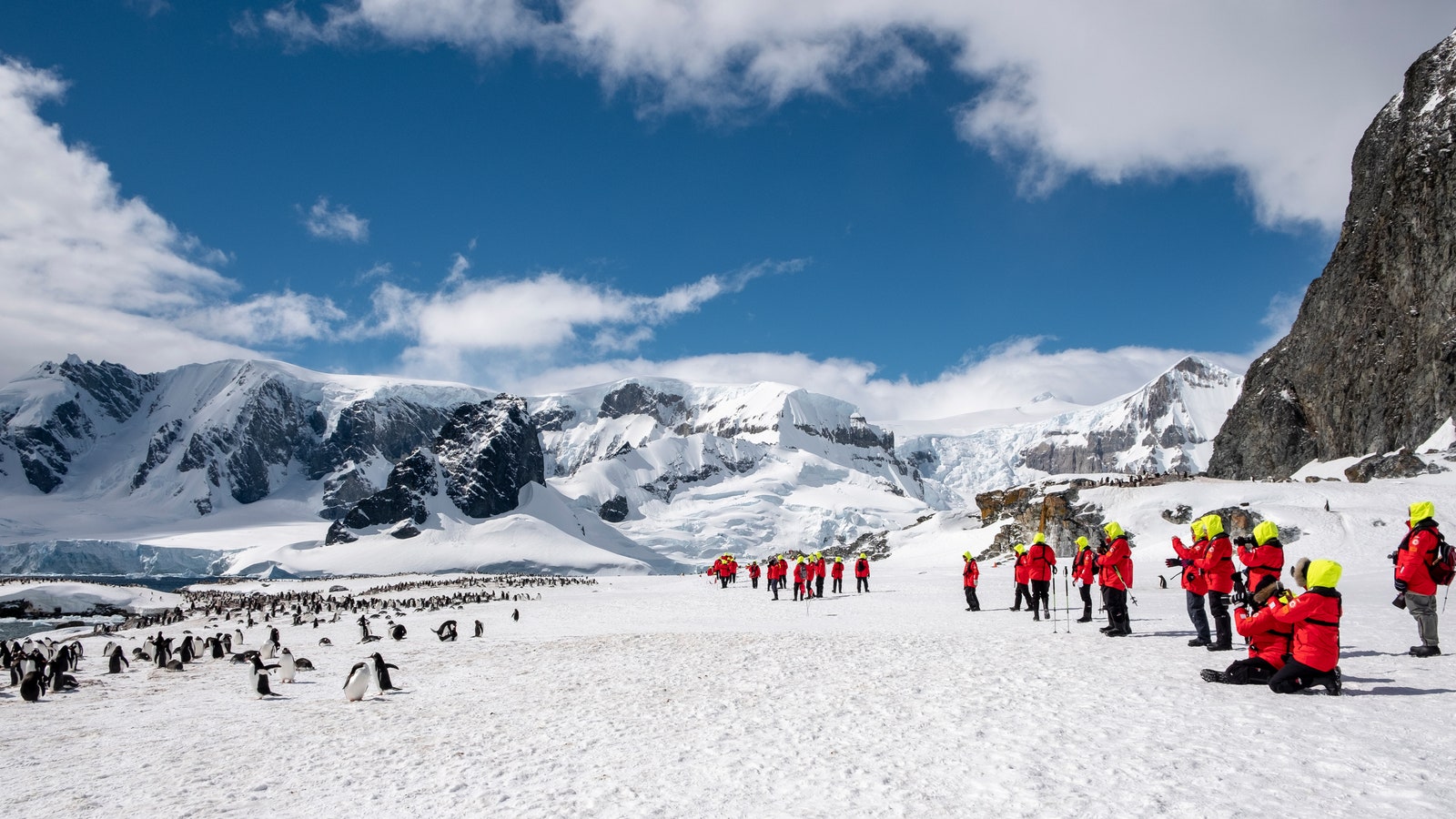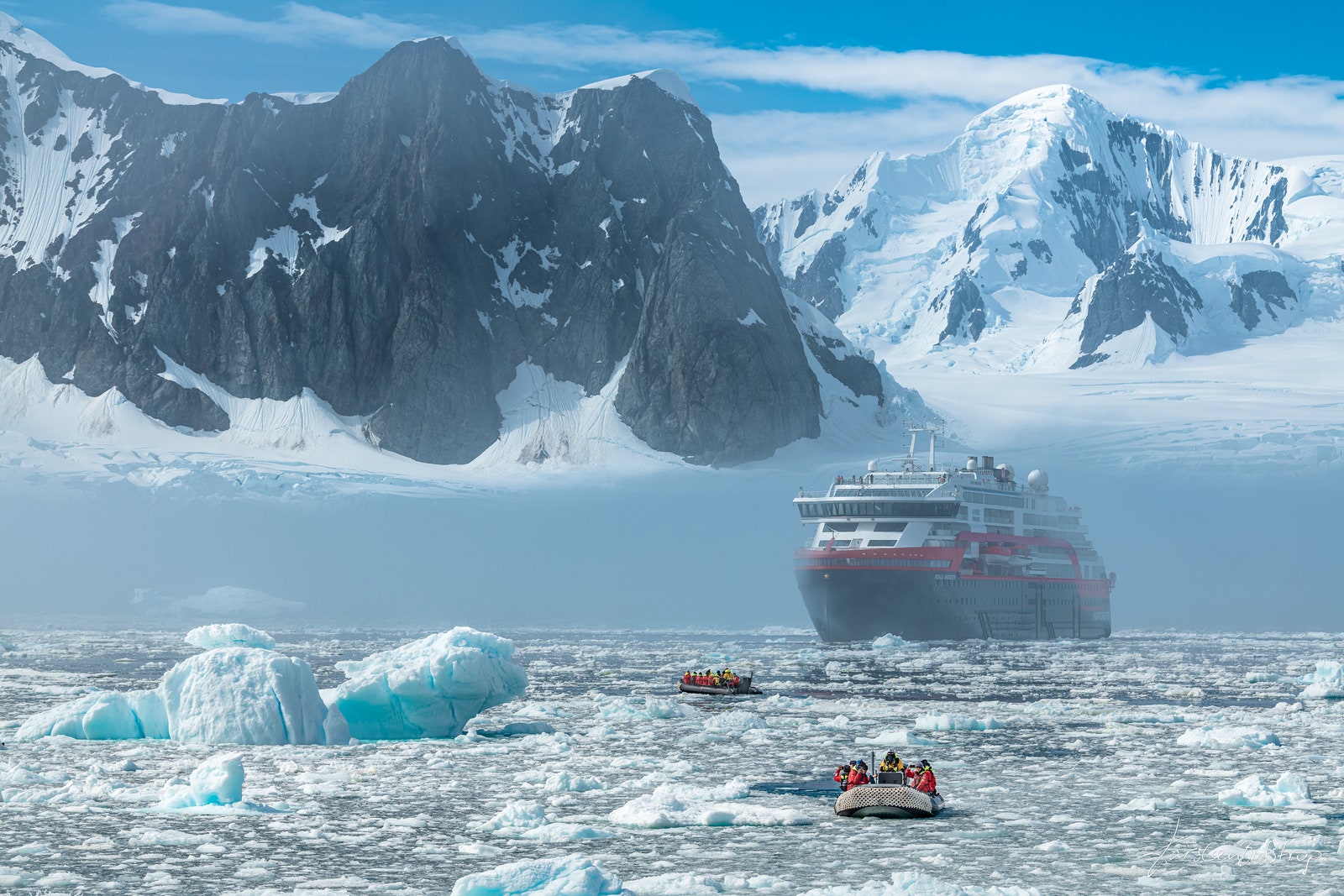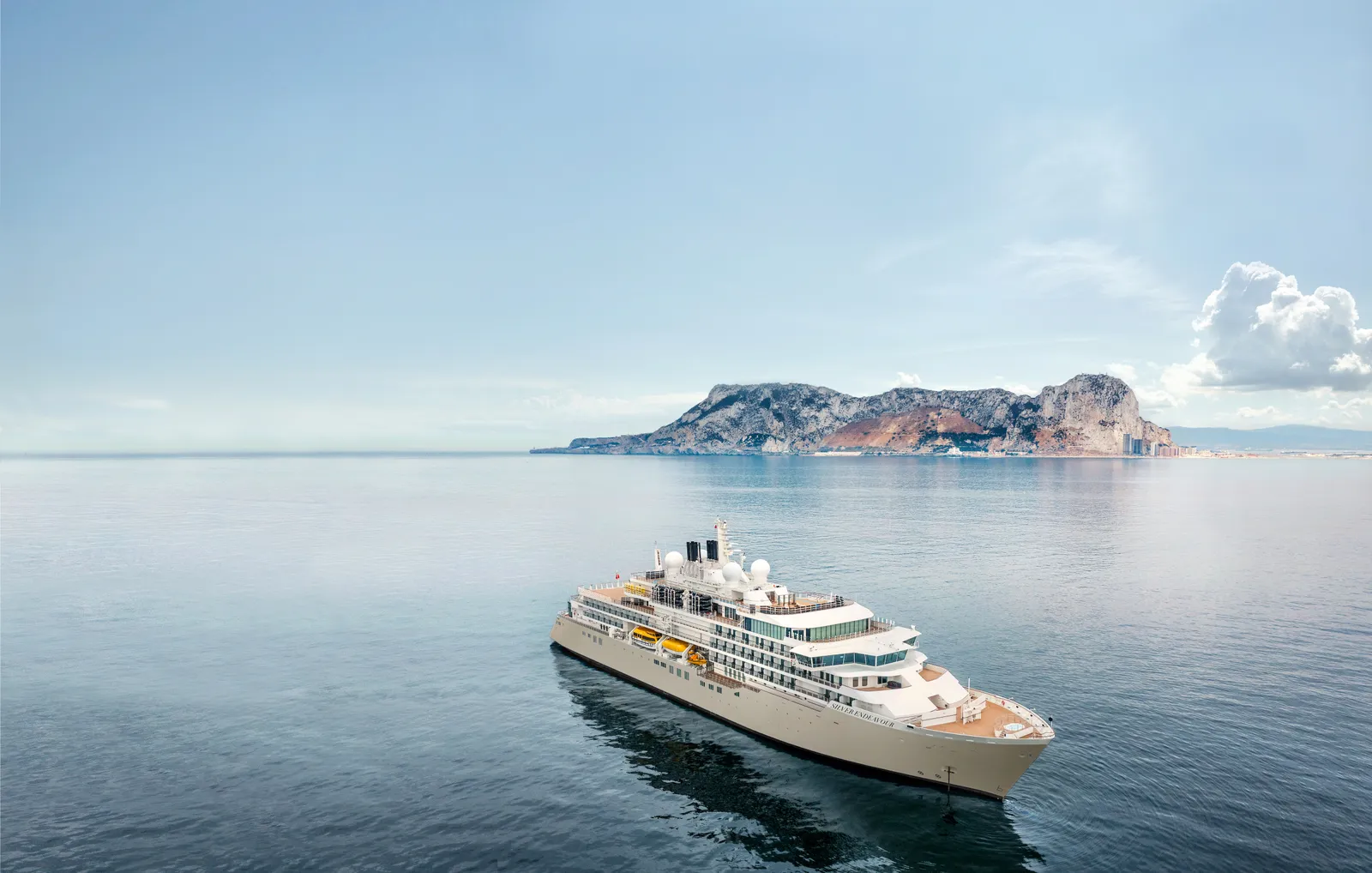CONDÉ NAST TRAVELER Everyone, It Seems, Is Cruising to Antarctica
By Megan Spurrell | 03-03-2023 |
Travel specialists are reporting record cruise bookings—but what does that mean for the White Continent's fragile landscape?
“I love telling people that Antarctica will be the trip of their lifetime, and they kind of roll their eyes. And then they come back, and they say, ‘You were absolutely right. Antarctica wasn’t just the seventh continent—it was the most amazing experience of my life.’”
James B. McClintock, professor of polar and marine biology at the University of Alabama at Birmingham, has experienced the wonder of the White Continent repeatedly over the past 30 years, on more than 15 research expeditions. But even after three-month stints on the dramatic tundra, at bases like the McMurdo and Palmer stations, McClintock struggles to put the magic of Antarctica into words. It’s the unimaginable scale of the landscape. The huddles of penguins, with no innate fear of humans—it’s ethereal, otherworldly, and yet none of that is enough to describe just how special Antarctica is.
McClintock is far from the only one who feels its pull. Despite the unattainable allure the destination has held for much of the world, Antarctica has, in recent years, hit the mainstream. Travel magazines like ours house glossy spreads of the imposing blue-and-white landscape. Instagram is flooded with reels and photo dumps of wide-eyed civilians getting their first glimpse of ‘The Ice,’ and wading ashore in borrowed boots. Youtube’s biggest content creators are posting their dispatches (a video from the tireless Mr. Beast of his landing, shared last month, has nearly 100 million views). Everyone, it seems, is going to Antarctica.

Hurtigruten travelers visit a penguin colony on Cuverville Island in Antarctica, one of many stops on the popular Antarctic peninsula. Andrea Klaussner
Okay, maybe not everyone. The final count of visitors to Antarctica during the 2021-2022 tourism season—Antarctica’s austral summer, from October to March—was 23,527 according to the International Association of Antarctica Tour Operators (IAATO). (I was one of those travelers.) That number represents an infinitesimal 0.00029 percent of the world’s population. The vast majority of this travel is done by cruise ship.
Travel specialists say, interest in Antarctica cruising is at an all-time high—and they expect bookings to continue to rise. “Interest in Antarctic cruising has been increasing year over year for the past decade,” says Ashton Palmer, president of Expedition Trips. “We have seen a steady increase as more companies operate trips to Antarctica, and therefore do more marketing to raise awareness—and the desire to travel farther and to more remote locations has become ever more popular.”
Mary Jean Tully, who books guests on luxury lines like Seabourn has seen the same pattern off the back of growing, and ever-more-fabulous industry offerings. “The curiosity has been there for a while, however with more new luxury expedition ships entering the marketplace, the inquiries and bookings we’re receiving are amazing. There is so much interest, now more than ever.” Just this season, Seabourn Cruise Line, Atlas Ocean Voyages, and Silversea Cruises have all put new expedition ships in Antarctic waters (the Seabourn Venture, Atlas World Traveller, and Silversea's Silver Endeavor, respectively).
Noah Brodsky, the chief commercial officer at Lindblad Expeditions—the company started by Lars Eric Lindblad, who lead the first civilian expedition to the continent in 1966—says the outfitter had their biggest-ever booking day for Antarctica sailings at the start of January 2023, with reservations up 14 percent over their previous record. “We have an unprecedented 20 Antarctica departures in the 2023-2024 season, and five of them are already full,” Brodsky says. He expects 2023 to be a “record-breaking year” for bookings.
Many, like Palmer, hear from guests who have been to every other continent and are ready for number seven. The tick of climate change’s clock adds an undeniable pressure. “Climate change and fear of its effects on these regions has heightened the urgency—travelers are prioritizing the destination now, before it is too late,” says Torstein Gaustad, an expedition leader on Hurtigruten’s hybrid-powered MS Fridtjof Nansen.
This reality is undeniable: Antarctica, a place so many travelers dream of seeing during their lifetimes, is changing quickly. Studies led by NASA researchers published in August 2023 found that the edge of the Antarctic ice sheet is “shedding icebergs faster than the ice can be replaced,” with estimates of 12 trillion metric tons of ice loss from the continent’s floating ice shelves since 1997. The British Antarctic Study reports that the mean annual temperature of the Antarctic Peninsula—where the bulk of tourism is focused—rose by more than 37 degrees Fahrenheit (3.2 degrees Celsius) in the second half of the 20th century. Trey Byus, chief expedition officer with Lindblad Expeditions, has personally observed penguin colonies that are “completely re-colonizing elsewhere” due to their changing home.
What does it mean, then, for thousands of visitors to arrive in ever-increasing numbers by cruise ships? Is this last-chance tourism only speeding up the process?
“The simple answer is that wherever human activity exists in the world, there will always be impacts of some degree, some positive, some negative,” says Amy Berquist, vice president, conservation, education, and sustainability at Lindblad Expeditions-National Geographic voyages. “If operators are not careful, increasing tourism numbers could also mean greater threat, which is why it’s imperative that everyone bold enough to travel there is also bold enough to educate travelers and share knowledge and experience across the industry, to increase safety and a broad-based commitment to responsible travel.”
Berquist, like many in the industry, believes that Antarctica is well protected by the Antarctic Treaty and IAATO oversight, among regulations from other bodies. The treaty, first signed in the U.S. in 1959 and now counting 56 nations as signatories, includes environmental stipulations for travel to the continent. It’s why, on my Viking Octantis cruise in March 2022, we had all of our clothing aggressively vacuumed before going ashore, to avoid the possibility of introducing foreign specimen; it’s also why only 100 of us, from our ship with over 200 guests onboard, could make a landing at one time.
On a Silversea expedition in Antarctica, guests get a firsthand look at calving glaciers. Luca Locatelli/Silversea
Zodiac expeditions take Silversea guests closer to the continent itself. Luca Locatelli/Silversea
IAATO, meanwhile, is an organization of tour operators, agents, and others in the space who have committed to abiding by environmental protocol outlined by the treaty, and then some. “We began observing the trend of increasing interest in the region long ago,” says Lindblad’s Byus. “It’s why, in 1991 we joined with six other private tour operators to found IAATO, establishing the guiding principles for safe and environmentally-friendly private-sector travel to Antarctica.”
Today, the organization is arguably unlike anything else in the industry. “There’s this whole network set up to keep an eye on each other, and to record things,” says McClintock, “and as far as I can tell, from an outside observer on that system, there’s a lot of peer pressure and it seems to work very well.”
New rules and regulations are coming from organizations like the Antarctic Treaty committee and IAATO all the time. McClintock played a role in having Zodiacs on all ships going to Antarctica switch from two cycle engines to four cycle, which are cleaner and quieter. “You do not want to see an oily sheen on the water down there, and that was happening with two cycle engines,” he says. In 2010, the International Maritime Organization banned cruise ships from burning heavy fuel oil in Antarctic waters. “That required a higher quality fuel to be burned, and really knocked out some of the big 2,000 passenger ships that were heading down—and those ships did not have reinforced hulls.” (In other words, a spill possibly waiting to happen, he says.) Dynamic positioning technology allows ships to avoid dropping anchors on the seafloor, preventing damage to sea life; ships have reduced underwater noise pollution, with Viking’s Octantis and Polaris recently receiving SILENT-E notations; Lindblad-NatGeo’s operations are entirely carbon neutral, and single-use plastics have been eliminated onboard.

A Hurtigruten ship is docked off of Peterman Island, as guests go ashore in smaller groups. Only 100 travelers from a single ship can be on land at one time, according to rules set out by the Antarctic Treaty. Karsten Bidstrup
IAATO is a self-governing body, to be clear. And most of the environmental initiatives taking place on cruise ships are at the behest of private companies. But McClintock is among a number of scientists I spoke to who feel confident in the rules and regulations set out, and the efforts made by the industry to get ahead of the impact of tourism. “My sense is that there's a lot of looking over the shoulder of that cruise industry,” says McClintock.
Others are bolstered in their optimism for Antarctic cruising by the fact that there's actual science happening aboard a number of these ships—citizen science, like tracking humpback whales and counting bioplastics in water samples, sure, but also full-on white coat-donning scientists conducting critical research aboard vessels from Viking and Ponant, to name a couple. It’s easy to be skeptical about the value of this work, as a guest—it sounds too easy—but one scientist after another asserts its value. “We’ve sponsored researchers to go along on Ponant trips and do actual frontline scientific research,” says Richard Garriott, president of The Explorer’s Club, which is partnering with Ponant on onboard programming for a series of sailings from 2024-2026. “There's incredible science being brought back that is important for all of us living around the earth right now.”
"Tourism is a risk that needs to be managed well, but it absolutely can be done in a way that is non threatening and non harmful. We just have to make sure people choose to do that.”
– RICHARD GARRIOTT, PRESIDENT OF THE EXPLORER'S CLUB
With a greatly compromised (read: rapidly melting) ice pack in the Arctic, Antarctica’s nearly three mile-deep ice sheet provides a unique environment for studies on everything from astronomy to wildlife, to systems that could enable humans to survive on Mars, says Garriott, and the landscape allows the use of devices impossible to set up anywhere else on the planet. “The tourists who ride on these expeditions are, in many ways, subsidizing that research,” says Garriott. “This public-private partnership, in the modern era, is almost the only way to get science done.”
When it comes to weighing the pros and cons of leisure tourism, Garriott strongly believes the scale tips in favor of responsible travel. “I wouldn't put tourism as Antarctica’s biggest threat,” says Garriott. “The number one is climate change itself. That is going to deteriorate the ice sheet that covers Antarctica. Tourism is a risk that needs to be managed well, but it absolutely can be done in a way that is non threatening and non harmful. We just have to make sure people choose to do that.”
These are a few of the reasons why McClintock, a lifelong Antarctic research biologist, became a “reluctant cruise naturalist lecturer” who now does one sailing to Antarctica per year with Abercrombie & Kent. After 15 years, he is no longer iffy about cruising to the continent. “My trepidations to tourism in Antarctica were largely unfounded,” he says. “I gave it a shot because I’m very focused on outreach, as it relates to global climate change. Now, I’m sold.” Part of what won McClintock over was not only being able to discuss the subject of our changing planet with guests, but the chance to speak to travelers who, having also seen the fragility of Antarctica in person, are often driven to become ambassadors for the continent when they return home. It’s another sounds-too-good scenario that he says he’s seen in action.

Guests aboard ships like the Silver Endeavor are often called Antarctica ambassadors—after firsthand seeing the continent, and the impact of climate change, they may be moved to advocate for protection of the fragile environment long after their trip. Silversea
“There’s this element of Antarctic ambassadorship that comes out of this experience, and it’s hard to put an exact metric on it, but I think it’s happening,” says McClintock. “I had somebody who said, ‘I’m going to go back and talk to my congressman who lives down the street.’ Many of them know their senators and congressmen and go back and advocate issues related to climate and conservation. These folks on Antarctica cruises are doers. To me, that’s a big positive.”
Some, of course, hold on to their reservations about tourism—more is more, they say. More people, more pollution, more damage. “While I love the fact that tourism allows a glimpse into this incredible environment resulting in many tourists then becoming a passionate voice for its protection, I do worry about, at least the Peninsula, being overrun with tourism and with that, presenting numerous dangers,” says Maggie Amsler, a biology researcher currently based at Palmer Station on Anvers Island. “Garbage, like plastic water bottles, are increasingly washing up on outer island shores. Smaller, private charters aboard yachts are on the increase, and there seems to be little oversight of their activities. There have been incidents over recent years wherein vessel passengers have been put ashore to explore on islands that are protected or the area has sensitive habitats or wildlife. If the vessel’s crew is not familiar with the local restrictions, what other regulatory aspects of Antarctic cruising are being overlooked?”
Amsler doesn't think the jury is completely out on cruising—she says she “absolutely” sees some value in the ambassadorship—but she is adamant that it is every traveler's responsibility to thoroughly research who they travel with, and to continue to push the industry in the right direction. “Choose wisely when selecting the cruise or tour company,” says Amsler. “Scrutinize how green and sustainable the itineraries and shipboard practices are. When onboard, be sure to hold them accountable for actions and make public any shortcomings experienced.”
Fortunately, several companies are leading the way on sustainable innovation in the space. "I am very impressed with the advances in sustainability incorporated into the newest wave of expedition vessels," says Palmer. "Standouts include Quark Expeditions’ Ultramarine, Lindblad Expeditions-National Geographic Resolution and Endurance, and Seabourn’s Venture and Pursuit. These state-of-the-art vessels are pushing the envelope with their innovative and environmentally friendly design and offer travelers the most sustainable approach to remote exploration."
Travelers shouldn't make any sacrifices on their expectations for thoughtful Antarctic cruises. And if a company falls short on sustainable policies, passengers should be vocal. “There needs to be increasing pressure to make sure that the regulations are being followed,” adds McClintock.
All of this puts an enormous responsibility—and power—in the hands of leisure travelers to Antarctica. It's about not being the person using a plastic water bottle on-board, for starters—but that type of thinking has to continue well before and after the trip. It's as simple as carbon offsets for flights, and reducing single-use plastics, and even rethinking our relationship to driving, which according to Garriott, is responsible for a carbon footprint greater than aviation and Antarctic cruising combined. Amsler agrees: “Antarctica can be protected by everyone by developing sustainable, earth-friendly practices at home."







